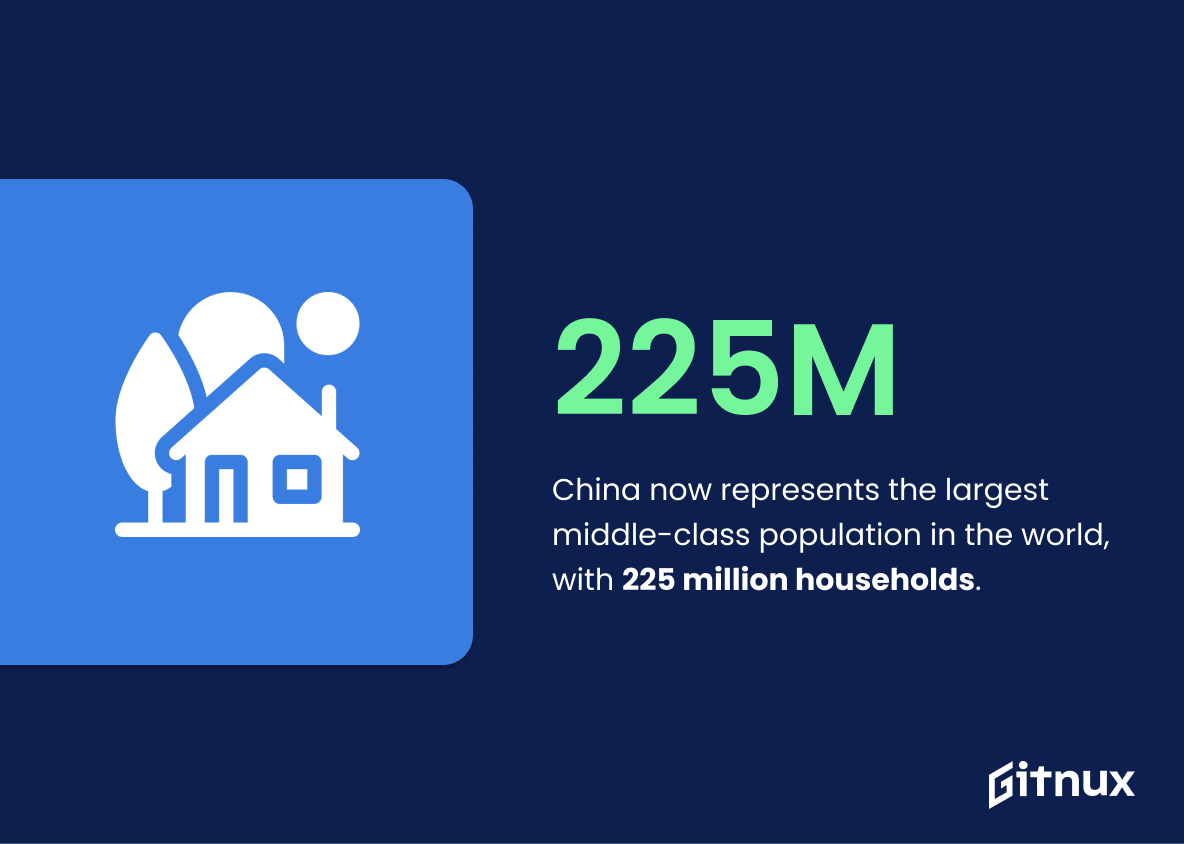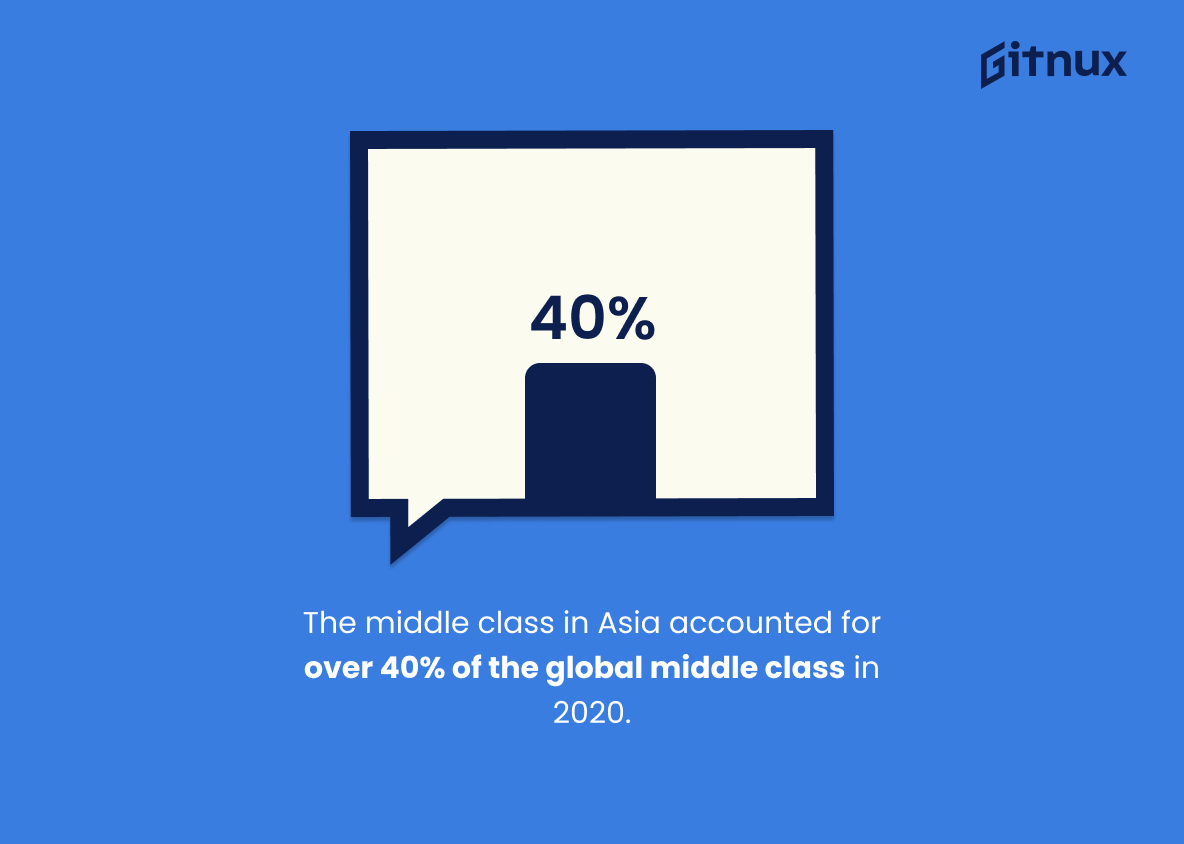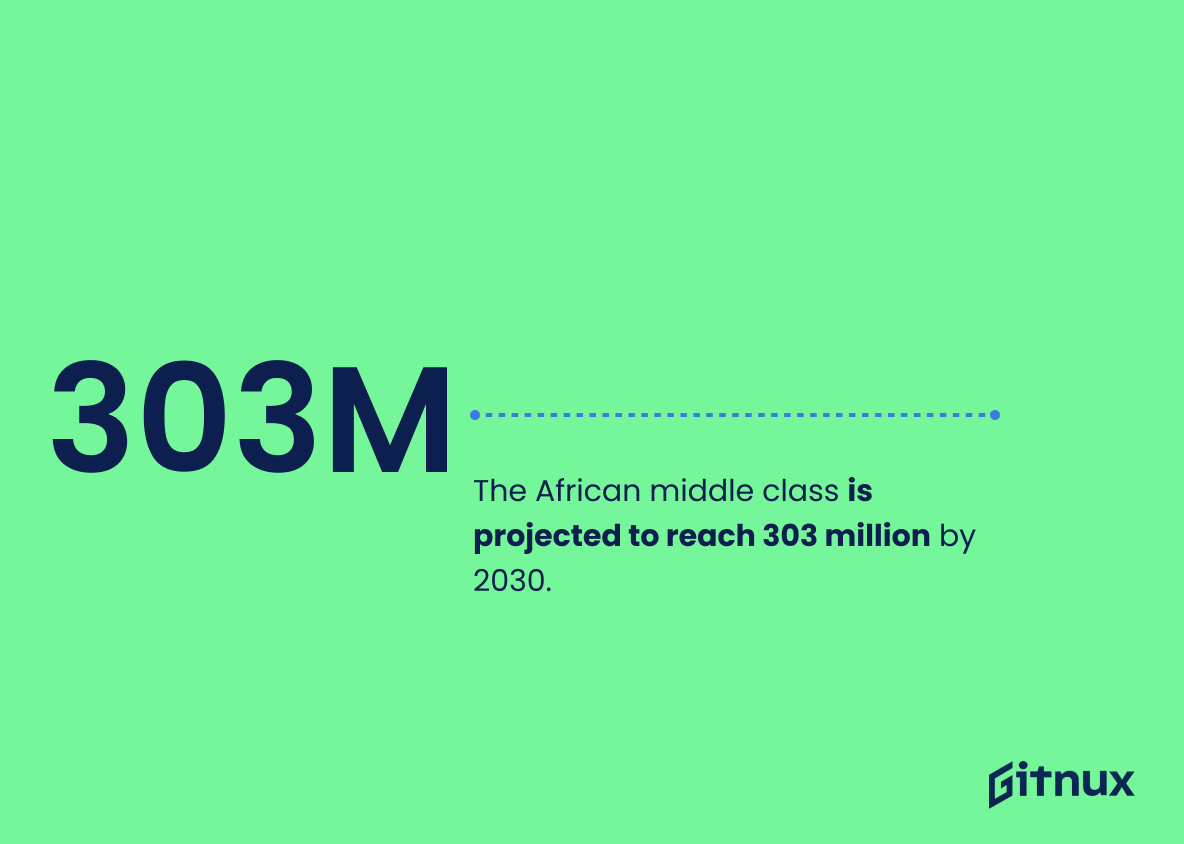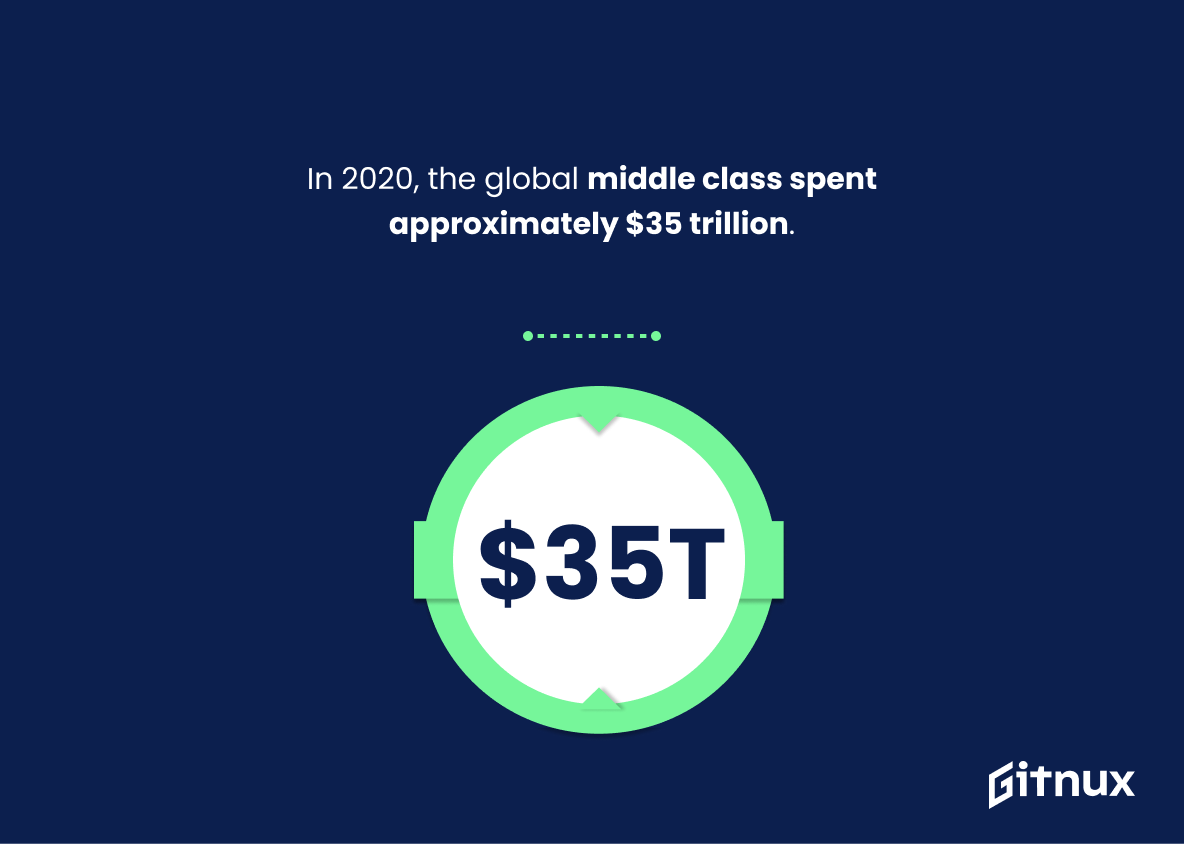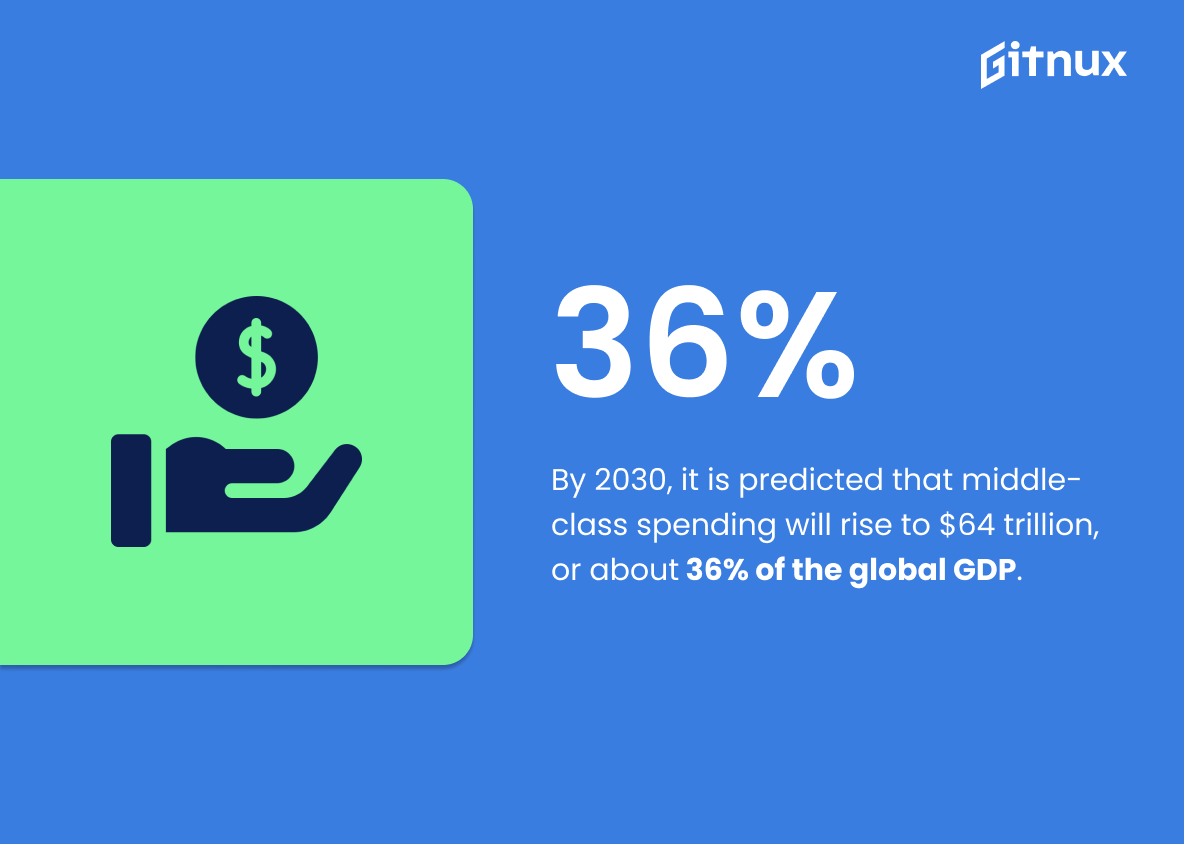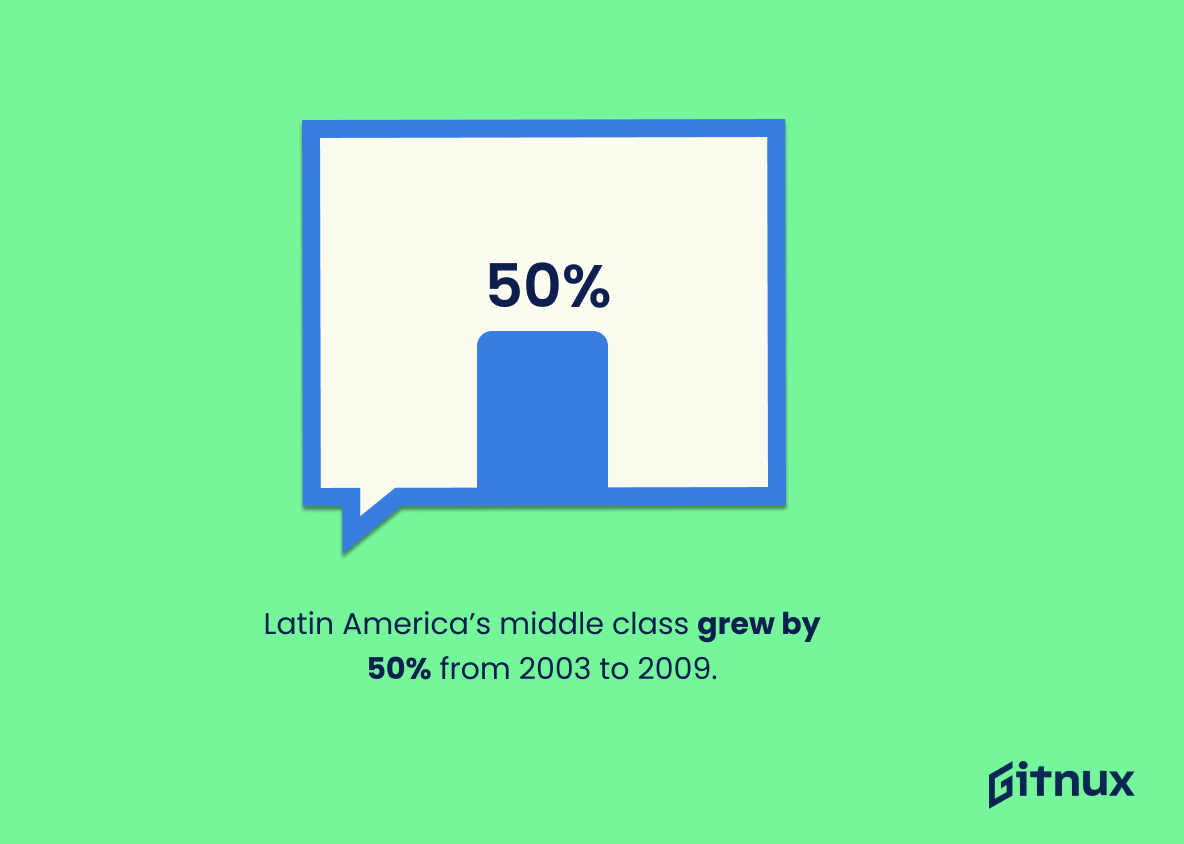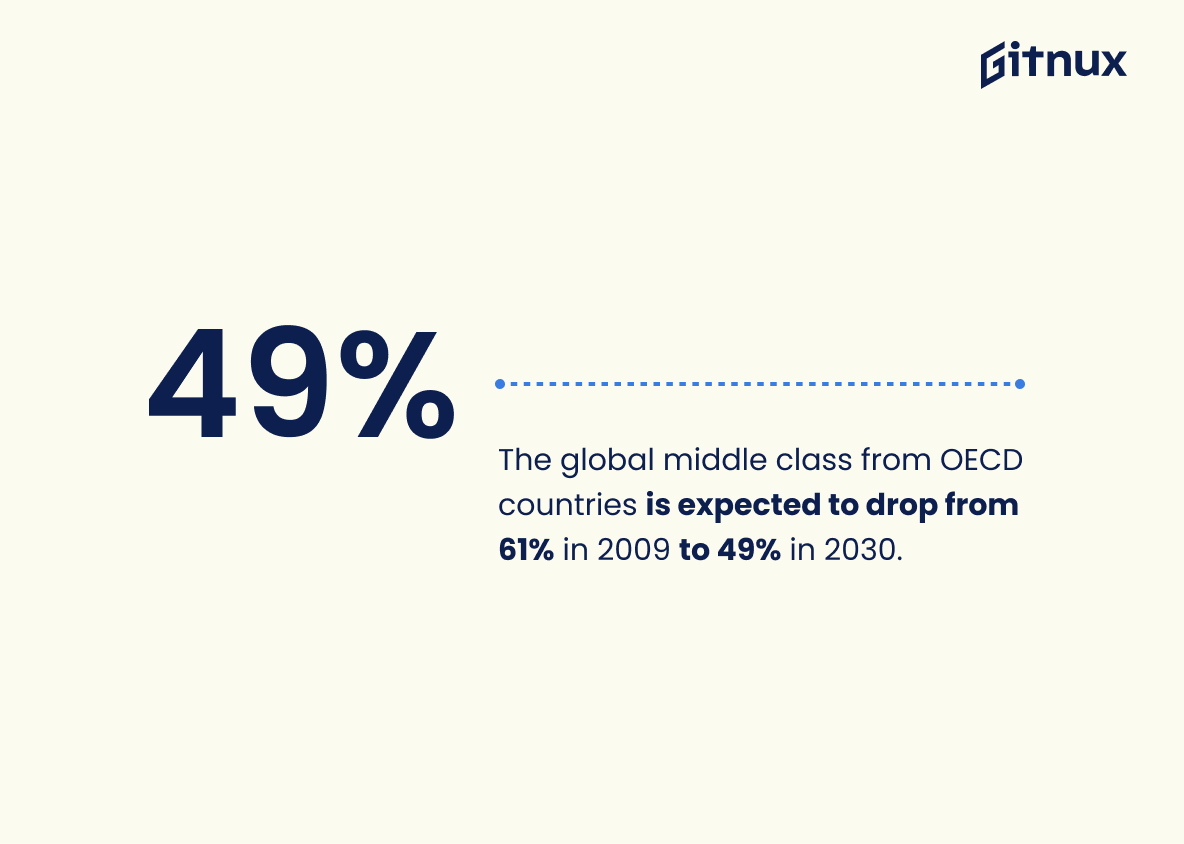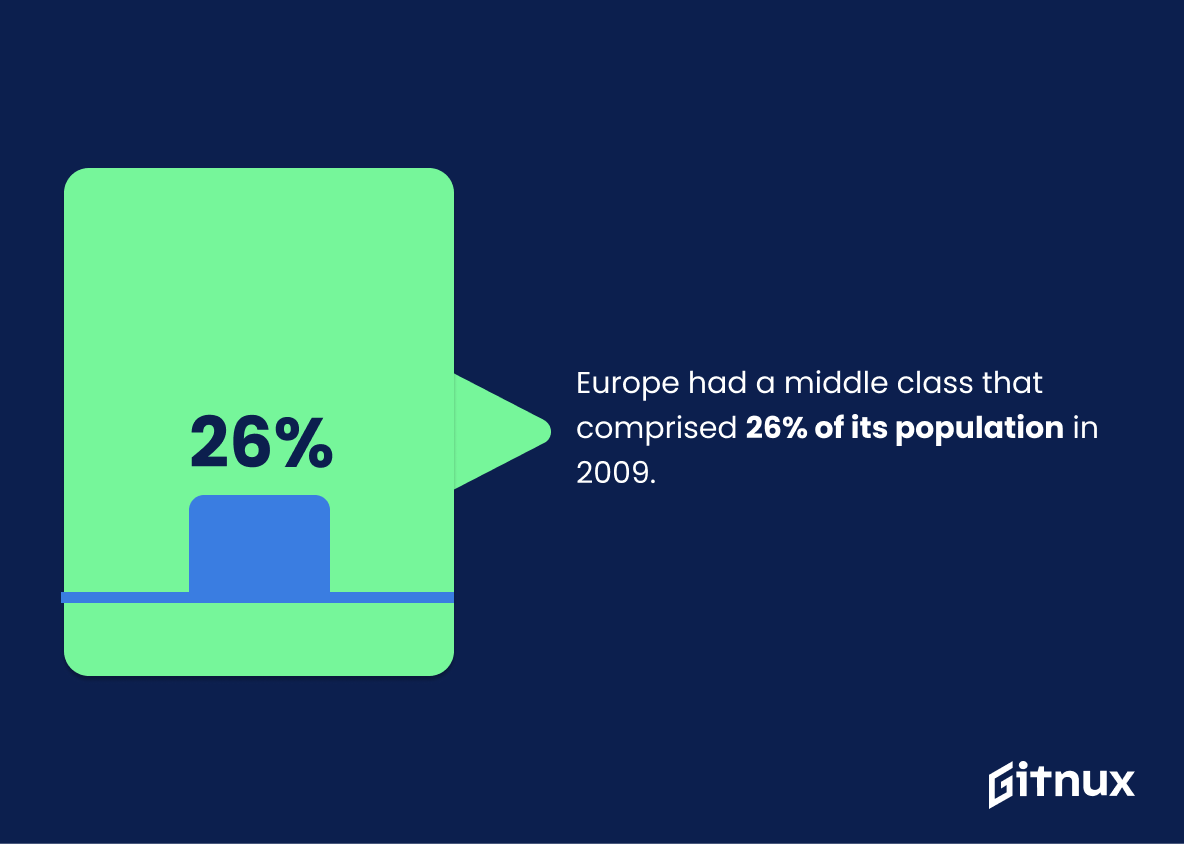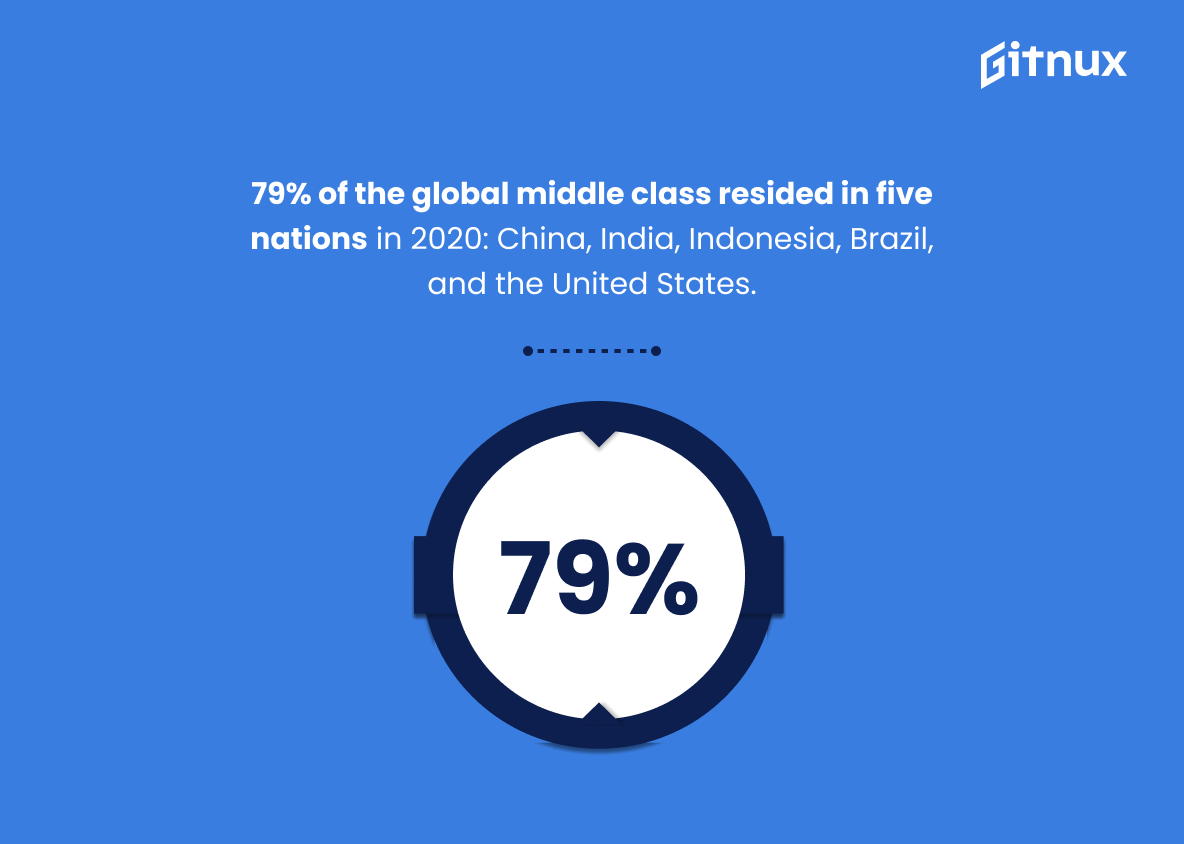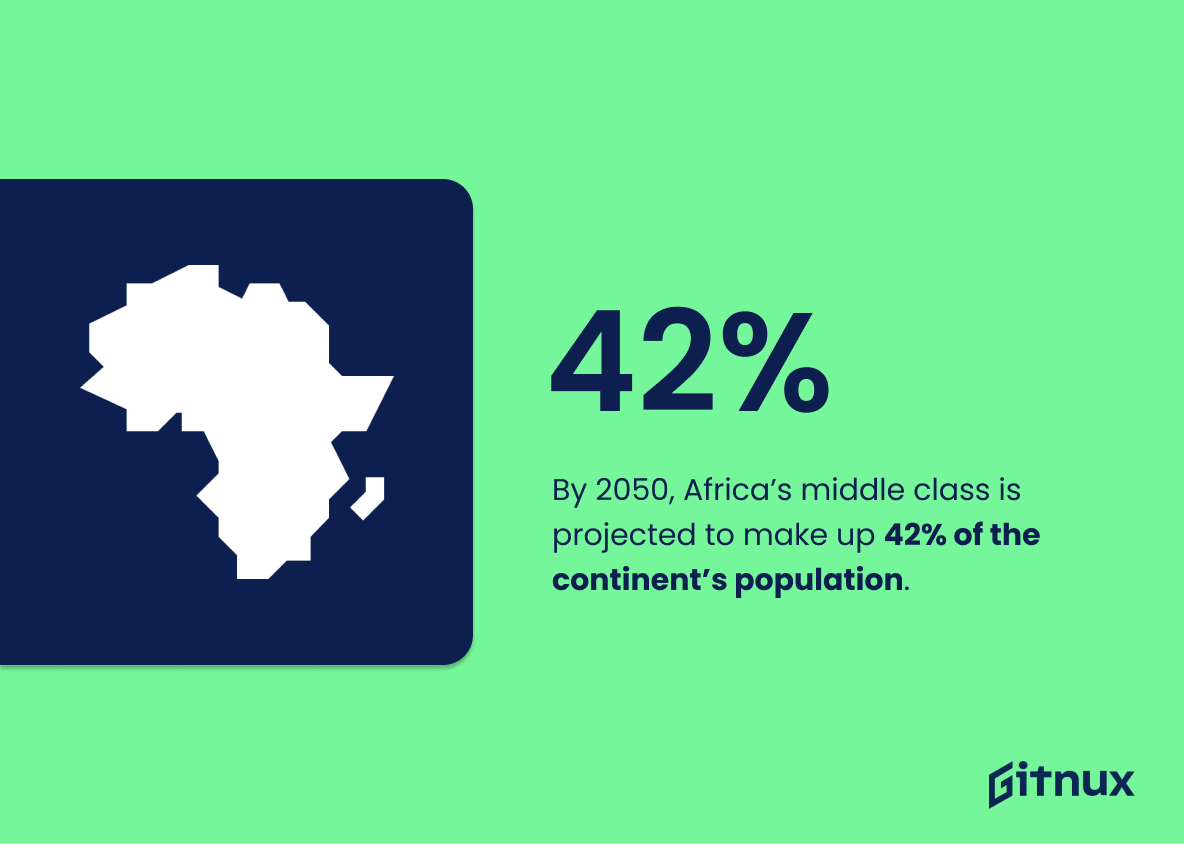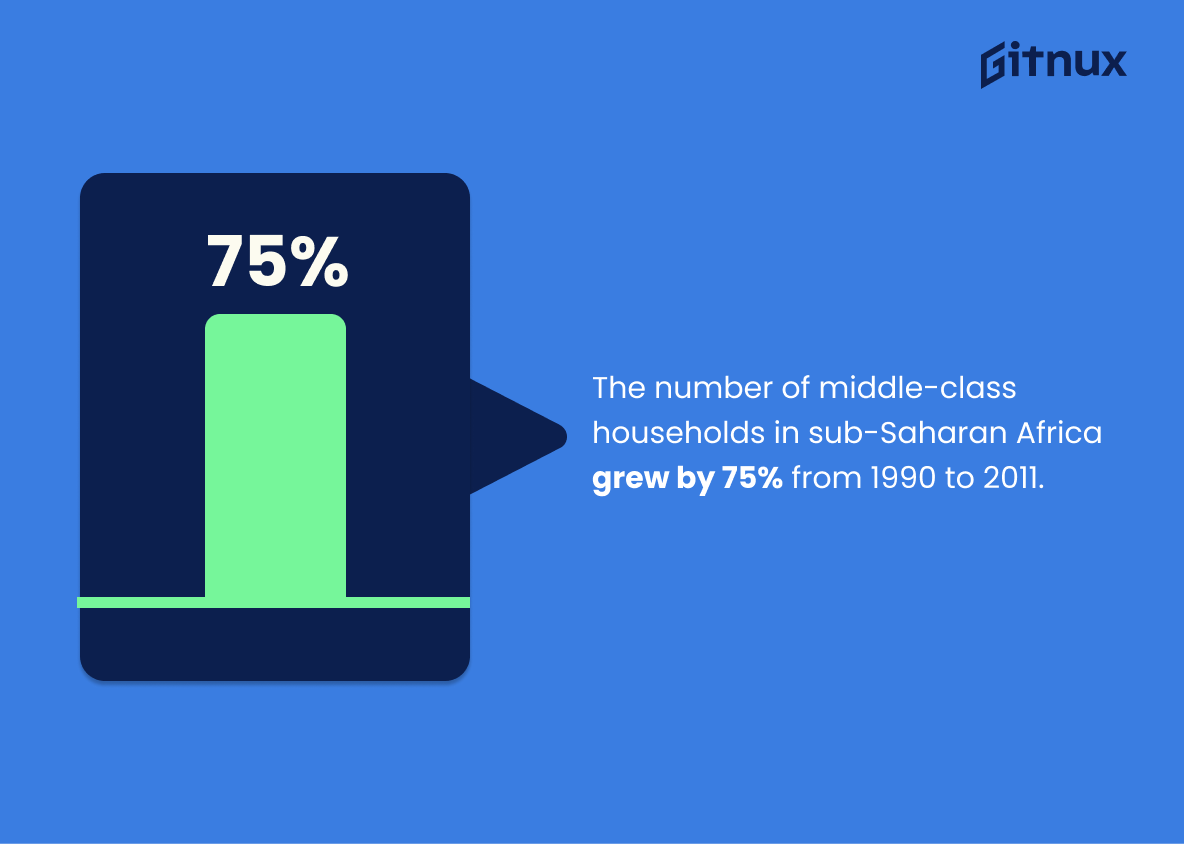The global middle class comprises about 3.8 billion people, 48% of the world’s population. It’s growing by 160 million annually. China leads with 225 million middle-class households. Asia represents 40% of this group, with its share set to hit 66% by 2030. By then, middle-class spending could jump from $35 trillion to $64 trillion, or 36% of global GDP. Africa’s middle class is forecasted to reach 303 million by 2030.
Between 2003-2009, Latin America’s middle class grew by 50%. OECD nations may drop from 61% to 49%. While Europe held 26% in 2009, India’s growth might surpass them. Currently, 79% of the middle class is in five countries: China, India, Indonesia, Brazil, and the US. By 2050, Africa might dominate with 42%. Since 1970, purchasing power parity rose over 200%. Emerging economies may see a 108% growth by 2030, and sub-Saharan Africa witnessed a 75% rise between 1990-2011.
Let’s take a closer look at the most important statistics about the global middle class.
This statistic is a powerful indicator of the sheer size of the global middle class. It serves as a reminder that nearly half of the world’s population is part of this growing demographic, and that their collective economic power is a force to be reckoned with. It is a reminder that the global middle class is a major player in the global economy, and that their needs and wants must be taken into account when making decisions about the future of the world.
The worldwide middle class is expected to grow by 160 million people per year.
This statistic is a powerful indicator of the rapid expansion of the global middle class. It speaks to the increasing economic opportunities available to people around the world, and the potential for increased economic growth and stability. As the middle class grows, so too does the potential for increased consumer spending, investment, and economic development. This statistic is a testament to the progress being made in the global economy, and the potential for a brighter future.
Global Middle Class Statistics Overview
China now represents the largest middle-class population in the world, with 225 million households.
This statistic is a powerful reminder of the sheer size of the Chinese middle class. It is a testament to the country’s economic growth and the potential of its citizens to become more prosperous. It also serves as a reminder of the importance of the global middle class in driving economic growth and stability. As the world’s largest middle-class population, China’s success is a beacon of hope for other countries looking to increase their own middle-class populations.
The middle class in Asia accounted for over 40% of the global middle class in 2020.
This statistic is a powerful indicator of the growing importance of the Asian middle class in the global economy. It highlights the fact that the middle class in Asia is now a major player in the global middle class, and its influence is only likely to increase in the years to come. This is an important point to consider when discussing the future of the global middle class and the implications it has for the world economy.
The African middle class is projected to reach 303 million by 2030.
This statistic is a powerful indicator of the potential for economic growth in Africa. By 2030, the African middle class is projected to more than double in size, indicating a significant increase in the purchasing power of African consumers. This could lead to a surge in demand for goods and services, creating new opportunities for businesses and entrepreneurs. Furthermore, the growth of the African middle class could lead to increased investment in infrastructure, education, and healthcare, which could have a positive impact on the overall quality of life in the region.
By 2030, 66% of the global middle-class population is expected to be in Asia.
This statistic is a powerful indicator of the shifting dynamics of the global middle class. It highlights the fact that Asia is becoming an increasingly important player in the global economy, with a growing middle class population that is expected to outpace other regions in the coming years. This shift has far-reaching implications for businesses, governments, and individuals alike, and is an important factor to consider when discussing global middle class statistics.
In 2020, the global middle class spent approximately $35 trillion.
This statistic is a powerful indicator of the immense economic power of the global middle class. It demonstrates the sheer magnitude of the spending power of the middle class, and the potential for businesses to tap into this market. It also highlights the importance of understanding the needs and wants of the global middle class in order to effectively target them with products and services.
By 2030, it is predicted that middle-class spending will rise to $64 trillion, or about 36% of the global GDP.
This statistic is a powerful indicator of the growing influence of the global middle class. It shows that, in just over a decade, middle-class spending is expected to make up a significant portion of the global GDP. This is a clear sign that the middle class is becoming an increasingly important economic force, and one that businesses and governments must take into account when making decisions.
Latin America’s middle class grew by 50% from 2003 to 2009.
This statistic is a testament to the remarkable progress made in Latin America over the past decade. It demonstrates that the region has seen a significant increase in the number of people who can be considered part of the middle class, which is a key indicator of economic growth and stability. This growth in the middle class is a positive sign for the region’s future, as it suggests that more people are able to access the resources and opportunities necessary to improve their quality of life.
The global middle class from OECD countries is expected to decline from 61% of the world’s total in 2009 to 49% in 2030.
This statistic is a stark reminder of the changing landscape of the global middle class. It paints a picture of a future where the majority of the world’s population is no longer part of the middle class, and instead is relegated to a lower economic status. This shift in the global middle class has the potential to have far-reaching implications for the global economy, and it is important to understand the implications of this statistic in order to make informed decisions about the future.
Europe had a middle class that comprised 26% of its population in 2009.
The statistic that Europe had a middle class that comprised 26% of its population in 2009 is a crucial piece of information when discussing global middle class statistics. It provides a snapshot of the economic landscape of the continent at a specific point in time, and can be used to compare and contrast with other regions of the world. Additionally, it can be used to track the progress of the European middle class over time, and to identify any trends or changes in the size and composition of the middle class. This data is essential for understanding the global middle class and its impact on the world economy.
79% of the global middle class resided in five nations in 2020: China, India, Indonesia, Brazil, and the United States.
This statistic is a powerful indicator of the current state of the global middle class. It reveals that the majority of the world’s middle class population is concentrated in just five countries, highlighting the stark inequality between the world’s wealthiest and poorest nations. This statistic is a reminder of the need for global economic reform to ensure that all countries have access to the same opportunities and resources.
By 2030, India is estimated to have the largest middle-class population in the world.
This statistic is a powerful indicator of the potential of India’s economy in the coming years. It speaks to the country’s ability to create a strong and vibrant middle class, which is essential for economic growth and stability. By 2030, India is projected to have the largest middle-class population in the world, which could lead to increased consumer spending, investment, and job creation. This could have a positive ripple effect on the global economy, making it an important statistic to consider when discussing global middle class statistics.
By 2050, Africa’s middle class is projected to make up 42% of the continent’s population.
This statistic is a powerful indicator of the potential for Africa’s economic growth in the coming decades. It suggests that the continent is on track to become a major player in the global middle class, with a large and growing population of people with the means to purchase goods and services. This could lead to increased investment in the continent, creating jobs and stimulating economic activity. It could also lead to increased access to education and healthcare, helping to reduce poverty and inequality. In short, this statistic is a sign of hope for Africa’s future.
In the past 50 years, the global middle class has expanded by more than 200% in terms of its purchasing power.
This statistic is a testament to the incredible growth of the global middle class over the past half-century. It speaks to the power of economic development and the potential for individuals to improve their lives through hard work and dedication. It is a reminder that, despite the challenges of globalization, there is still hope for those who strive to make a better life for themselves and their families. This statistic is a beacon of light in a world of economic uncertainty, and it should be celebrated.
The number of middle-class households in sub-Saharan Africa grew by 75% from 1990 to 2011.
This statistic is a testament to the remarkable progress made in sub-Saharan Africa over the past two decades. It shows that the middle class in this region has grown significantly, indicating that more people are now able to access the resources and opportunities that come with a higher standard of living. This is an encouraging sign for the future of the region, and a reminder of the importance of continued investment in economic development.
Worldwide, the middle-class population has more than doubled since 2001.
This statistic is a testament to the remarkable growth of the global middle class over the past two decades. It highlights the fact that more and more people are able to access the resources and opportunities that come with being part of the middle class. This is an important development, as it can lead to greater economic stability and improved quality of life for many people around the world.
More than 50% of the global middle class could be living in both China and India by 2020.
This statistic is a powerful indicator of the rapid growth of the global middle class, particularly in China and India. It highlights the potential for these two countries to become major economic powerhouses in the near future, and the implications this could have for the global economy. It also serves as a reminder of the importance of investing in the development of these countries, in order to ensure that their citizens can benefit from the opportunities that come with a growing middle class.
Conclusion
The global middle class is a rapidly growing demographic, with estimates suggesting that it will reach 3.8 billion people by 2020 and continue to grow at an annual rate of 160 million people per year. China currently has the largest population of middle-class households in the world, but India is expected to overtake them by 2030. The African continent’s middle class is projected to triple from its current size over the next decade as well.
In terms of spending power, worldwide middle-class expenditure was estimated at $35 trillion in 2020 and could rise up to $64 trillion or 36% of global GDP by 2030. This growth can be attributed largely due to emerging economies such as Latin America which saw their own respective populations increase 50% between 2003 and 2009 alone. It appears clear then that this trend towards a larger global middle class shows no signs of slowing down anytime soon – making it essential for businesses around the world to understand how best they can capitalize on this opportunity going forward into 2021 and beyond.
References
0. – https://www.goldmansachs.com
1. – https://www.atkearney.com
2. – https://www.ey.com
3. – https://www.afdb.org
4. – https://www.weforum.org
5. – https://www.pewresearch.org
6. – https://www.ourworldindata.org
7. – https://www.csis.org
8. – https://www.fortuneindia.com
9. – https://www.pwc.com
10. – https://www.oecd.org
11. – https://www.qz.com
12. – https://www..deloitte.com
13. – https://www.worldbank.org
14. – https://www.brookings.edu
